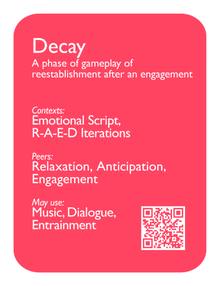Difference between revisions of "Decay"
ValterAlves (Talk | contribs) m |
ValterAlves (Talk | contribs) m |
||
| (23 intermediate revisions by the same user not shown) | |||
| Line 2: | Line 2: | ||
| name =Decay | | name =Decay | ||
| deckversion =1.0 | | deckversion =1.0 | ||
| − | | | + | | v10synopsis =A phase of gameplay of reestablishment after an engagement |
| + | | v20synopsis =A phase of gameplay of reestablishment after an engagement | ||
| patternpresentation = | | patternpresentation = | ||
| cardpresentation= | | cardpresentation= | ||
| − | | | + | | v10frontface =Decay-front-v10.png |
| − | | | + | | v10backface =Decay-back-v10.png |
| + | | v20frontface =Decay-front-v20.png | ||
| + | | v20backface =Decay-back-v20.png | ||
| screenshots= | | screenshots= | ||
| − | | | + | | v10rel-tag1=Context:<br> |
| − | | | + | | v10rel1=[[R-A-E-D Iterations]], [[Gameplay]], [[Emotional Script]]<br> |
| − | | | + | | v10rel-tag2=Peers:<br> |
| − | | | + | | v10rel2=[[Relaxation]], [[Anticipation]], [[Engagement]]<br> |
| − | | | + | | v10rel-tag3=May use:<br> |
| − | | | + | | v10rel3=[[Music]], [[Dialogue]], [[Entrainment]]<br> |
| + | | v20rel-tag1=Contexts:<br> | ||
| + | | v20rel1=[[Emotional Script]], [[R-A-E-D Iterations]]<br> | ||
| + | | v20rel-tag2=Peers:<br> | ||
| + | | v20rel2=[[Relaxation]], [[Anticipation]], [[Engagement]]<br> | ||
| + | | v20rel-tag3=May use:<br> | ||
| + | | v20rel3=[[Music]], [[Dialogue]], [[Entrainment]]<br> | ||
| revisions =Introduced in version 1.0 | | revisions =Introduced in version 1.0 | ||
| + | | description = | ||
| + | [[Decay]] is a transient phase in the game's [[Emotional Script]]. Its opportunity is dictated by the gameplay and it has a short duration. It aims at leading or supporting the player while changing from a state of high arousal (e.g., the end of an [[Engagement]]) to a state of low arousal (as [[Relaxation]]). Usually these several phases relate in a iterated sequence ([[R-A-E-D Iterations]]). | ||
| + | |||
| + | A common approach is to perform a fade out in the ongoing ([[Engagement]]) [[Music]]. Other approaches in term of [[Music]] include presenting a short piece of [[Music]] evoking "discharge" or to serve the piece that would be the ending of the ongoing composition. Other approaches using [[Entrainment]], are also interesting. Some designers also opted to explicitly informing the player about the change in arousal states through diegetic [[Dialogue]]. | ||
| + | |||
| examples= | | examples= | ||
| − | | ex1=<mt p="Decay" g=" | + | | ex1=<mt p="Decay" g="Halo" altg="Halo: Reach" w="{{R16by9W}}" h="{{R16by9H}}"></mt> |
| − | | ex2=<mt p="Decay" altg=" | + | | ex2=<mt p="Decay" g="Assassins Creed" altg="Assassin's Creed" w="{{R16by9W}}" h="{{R16by9H}}"></mt> |
| − | | ex3=<mt p="Decay" g=" | + | | ex3=<mt p="Decay" g="NFS Undercover" altg="Need for Speed Undercover" w="{{R16by9W}}" h="{{R16by9H}}"></mt> |
| − | | ex4=<mt p="Decay" g=" | + | | ex4=<mt p="Decay" g="Far Cry 2" w="{{R16by9W}}" h="{{R16by9H}}"></mt> |
| − | | ex5=<mt p="Decay" g=" | + | | ex5=<mt p="Decay" g="HalfLife2" altg="Half-Life 2" w="{{R8by5W}}" h="{{R8by5H}}"></mt> |
}} | }} | ||
Latest revision as of 14:55, 19 July 2012

|

| |
| The card's front face | The card's back face |
Contents
Synopsis
| A phase of gameplay of reestablishment after an engagement. |
Relationships
Contexts:
Emotional Script ![]() , R-A-E-D Iterations
, R-A-E-D Iterations ![]() .
.
Peers:
Relaxation ![]() , Anticipation
, Anticipation ![]() , Engagement
, Engagement ![]() .
.
May use:
Music ![]() , Dialogue
, Dialogue ![]() , Entrainment
, Entrainment ![]() .
.
Description
Decay is a transient phase in the game's Emotional Script. Its opportunity is dictated by the gameplay and it has a short duration. It aims at leading or supporting the player while changing from a state of high arousal (e.g., the end of an Engagement) to a state of low arousal (as Relaxation). Usually these several phases relate in a iterated sequence (R-A-E-D Iterations).
A common approach is to perform a fade out in the ongoing (Engagement) Music. Other approaches in term of Music include presenting a short piece of Music evoking "discharge" or to serve the piece that would be the ending of the ongoing composition. Other approaches using Entrainment, are also interesting. Some designers also opted to explicitly informing the player about the change in arousal states through diegetic Dialogue.
Examples





